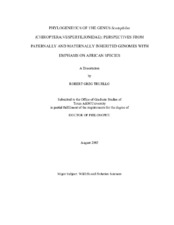Phylogenetics of the genus Scotophilus (Chiroptera: Vespertilionidae): perspectives from paternally and maternally inherited genomes with emphasis on African species
Abstract
Bats of the genus Scotophilus are distributed throughout sub-Saharan Africa, parts of southern and Southeast Asia, a majority of the Indomalayan Islands, Reunion Island, and Madagascar. The genus is composed of 14 recognized species with seven distributed throughout sub-Saharan Africa including: (S. dinganii (A. Smith, 1833), S. leucogaster (Cretzschmar, 1830), S. nigritellus de Winton, 1899, S. nigrita (Schreber, 1774), S. nucella Robbins, 1983, S. nux Thomas, 1904, and S. viridis (Peters, 1852). The remaining species include four from southern and southeast Asia (S. celebensis Sody, 1928; S. collinus Sody 1936; S. heathi (Horsfield, 1831); S. kuhlii Leach, 1821), two on Madagascar (S. sp. nov. Goodman et al., in press; and S. robustus Milne-Edwards, 1881), and one endemic to Reunion Island (S. borbonicus (E. Geoffroy, 1803). The systematics and taxonomy of this genus have been controversial and continue to be confusing. The genus is plagued with problems in species definition and the systematic relationships among members of the genus are poorly understood. The major goal of this study was to use a molecular phylogenetic approach to clarify some of the controversy and confusion surrounding the members of this genus. Nucleotide differences from mtDNA and the Y chromosome were used to examine phylogenetic patterns within Scotophilus. Based on these data two new species of Scotophilus were identified. Phylogenetically, African Scotophilus were found to comprise a monophyletic group with S. nux as the most basal African taxon. Overall, the Asian S. kuhlii was the most basal taxon. A distant relationship was identified between S. kuhlii and S. heathi, the other Asian species examined. The multiple origins of Malagasy Scotophilus are apparent as the two Malagasy taxa in the study do not share a sister-group relationship. The large bodied S. nigrita is closely related to S. dinganii and the S. dinganii-like species all share a close relationship. S. nigrita has a S. dinganii-like mtDNA haplotype and a very distinct zfy haplotype, suggesting a possible hybridization event with a S. dinganii-like ancestor.
Citation
Trujillo, Robert Greg (2005). Phylogenetics of the genus Scotophilus (Chiroptera: Vespertilionidae): perspectives from paternally and maternally inherited genomes with emphasis on African species. Doctoral dissertation, Texas A&M University. Texas A&M University. Available electronically from https : / /hdl .handle .net /1969 .1 /4337.


